OptiMSM® Tablets
OptiMSM® Tablets
- Highest quality MSM in the world, produced in the United States
- Each tablet contains 1000 mg of OptiMSM®
- Suitable for vegans
Description
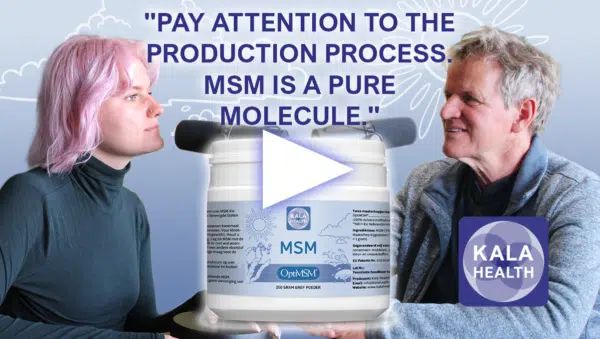
- OptiMSM® is the highest quality MSM in the world, produced by Bergstrom Nutrition in the United States
- OptiMSM® consists of 100% pure MSM, without further additives
- OptiMSM® is purified through 4-fold distillation, and is therefore virtually free of contaminants
- Each plant-based tablet contains 1000 mg OptiMSM®
- Suitable for vegans
KALA Health MSM tablets contain 1000 mg OptiMSM® each, the highest quality MSM available globally today.
These MSM tablets are manufactured using OptiMSM® ‘Microprills’. These fine, pure crystals stick together easily. This makes them the ideal crystals for tablet production, as little filler material is required.
Kala Health MSM tablets are manufactured in The Netherlands according to HACCP standards. Each tablet consists of over 90% OptiMSM®, proof that very few fillers are utilized. The main filler (also known as an excipient) used is vegetarian cellulose. Sodium carboxymethylcellulose is a special form of cellulose, which, due to its branched structure, absorbs moisture from the environment into the tablet. It allows the tablet to disintegrate much more rapidly in the stomach, meaning the MSM is absorbed quicker.
Due to their small size and elongated shape, the tablets are easy to swallow. Another advantage is the fact that the tablets are easy to break in two.
With Kala Health tablets, the daily dosage can be determined easily and accurately, and the tablets are a breeze to take.
Ingredients
Each tablet contains: 1000 mg OptiMSM® (99,9% pure Methylsulfonylmethane).
Recommended Dosage
Adults: Take 1-2 tablets twice daily, preferably with a meal, or as recommended.
Children: Adapt the dosage according to body weight.
OptiMSM®: MSM in its purest form
MSM (methylsulfonylmethane) is a small molecule with enormous importance for the body. The chemical formula for MSM is CH3SO2CH3. It is a small, light molecule with a molecular weight of just 94, which is why it is very easily absorbed by the body. MSM is the form in which sulfur occurs naturally in all living organisms, and in which it is biologically active. MSM occurs naturally in fruit, vegetables and, for example, in cow’s milk, provided the animals graze in pastures. It is an odourless, white powder that dissolves well in warm water and a wide range of organic solvents.
As far back as the 60s, MSM has been studied by scientists at the Health Sciences University in Oregon, United States, led by Professor Stanley W. Jacob M.D. Dr Jacob has documented his experiences in several books: “The Miracle of MSM, the Natural Solution for Pain” (1999) and “MSM, the definite guide” (2003).
OptiMSM® is the purest MSM available, manufactured by Bergstrom Nutrition in the USA. It is the only MSM in the world purified by means of multiple distillation. OptiMSM® is also the only MSM backed by published, peer-reviewed research. It is the only MSM in the world manufactured according to Robert J. Herschler’s global patents.
Different types of MSM
OptiMSM® exists in two forms, which differ in quality. First of all, there is a fine powder variety, known as the ‘Microprill’ quality. Due to its fine composition, its crystals cling together easily. This quality is mainly intended for making tablets, for which few fillers are needed. To keep the powder processable, 0.1% silicon dioxide is added (silicon dioxide is simply finely ground sand!). As such, one could say that this OptiMSM® quality is 99.9% pure.
The second OptiMSM® quality is a coarse powder, known as the ‘Flake’ quality. These crystals are a bit rougher, and therefore cling together less easily. ‘Flakes’ are mainly intended to be mixed with feed and to be dissolved in water or fruit juice. However, due to the larger crystal size, dissolving it takes a little longer than with ‘Microprills’. OptiMSM® ‘Flakes’ aren’t just easier to mix into food: they are also free of added silicon dioxide. As such, one could say that the ‘Flake’ quality is 100% pure.
“Primal” supplier of sulfur
In the periodic table, the element of sulfur belongs to the same group as the element oxygen. Sulfur and oxygen are therefore closely related. In anoxic environments, organisms often use sulfur instead of oxygen as their energy source. As an example: in 1986, a subterranean cave was discovered in Romania that had probably not been in contact with the outside world for five million years. A total of 48 new invertebrate species were discovered in the cave. These animals owe their lives to warm, sulfur-rich water that wells up into the cave and fills it with high concentrations of hydrogen disulphide (H2S). To humans, this sulfur-rich gas would be deadly. For the bacteria, fungi and animals in the cave, however, it forms the basis for life.
Keep in mind that hundreds of millions of years ago, oxygen was still a rare element on planet Earth. Only after terrestrial plants began to develop did the oxygen content in the atmosphere increase. After that, it still took a long time for the oceans to absorb this oxygen. We know that hundreds of millions of years ago, algae in the oceans began producing simple organosulfur compounds, such as MSM. These sulfur compounds were probably the first and most important energy sources for all forms of life that evolved afterwards. This fuels the idea that these higher life forms may have been genetically programmed to use MSM as a sulfur source.
Several studies with laboratory animals have been performed using MSM, the sulfur in which was made radioactive (35S). These studies showed that MSM is partially broken down after oral intake, and the sulfur released is utilized by the body. The radioactive sulfur (35S) was found in the collagen and keratin that make up hair and nails. Surprisingly, radioactive sulfur was also found in amino acids called methionine and cysteine, and in blood serum proteins. This discovery proves that sulfur derived from MSM forms a part of the so-called methionine metabolism.
“Primal” supplier of methyl groups
Methyl groups are the building blocks that comprise all organic molecules. The body is constantly breaking down and rebuilding tissues and cells. Methyl groups are made available to molecules in our body millions of times per second. This process, called methylation, affects all processes of life. Without methyl groups, no new DNA can be formed, and thus, no new cells can be created. The formation of many different molecules is also dependent on methyl groups. This includes certain neurotransmitters, such as choline, serotonin, noradrenaline and adrenaline. Additionally, methyl groups are essential for the detoxification processes in the liver. Both a human being’s physical and mental health are completely dependent on sufficient methyl groups being made available.
Interestingly, the MSM molecule consists of two methyl groups and one sulfur atom (in the form of a sulfate group). An MSM molecule is broken down in the body into a sulfate (sulfur) group and two methyl groups, leaving no residue. It’s almost certain that MSM was an important, and perhaps the only, supplier of methyl groups for the primitive life forms that evolved hundreds of millions of years ago. Are all other life forms that evolved after this genetically programmed to use MSM as a methyl donor? That would seem to be the case.
MSM, interestingly, can be consumed by all life forms studied in almost unlimited quantities without any toxification symptoms. To put it in more technical terms: it has never been possible to determine a so-called LD50. This is the dose in a test set-up that causes 50% of the laboratory animals to die. On the contrary, Dr Jacob readily explains that the test animals he examined only became fitter and more energetic as he increased the dosage.
The half time of MSM in the human body is approximately 48 hours, and after 480 hours, MSM is still present in urine samples. This makes it the most stable source of sulfur and methyl groups for the body.
MSM: natural or synthetic?
Many people appear to struggle with questions as to the exact source of MSM. Is it natural or synthetic? Is it plant-based? Some producers claim that their MSM is “distilled from pine trees”. We also regularly come across claims of MSM being ‘of natural origin’, or even ‘organic’. Recently, we even heard from a distributor who claimed that their MSM would be all-vegetable, produced from vegetable oils such as linseed oil.
MSM is a naturally occurring substance, found in the human body and many foods. The richest source of MSM is breast milk, in concentrations of no more than a few milligrams per litre.
In theory, MSM could be extracted from pine trees. However, we would have to chop down most of the Earth’s pine trees to obtain a reasonable amount of MSM. In practical terms, this narrative is therefore unrealistic, as is the claim that MSM is of ‘natural origin’, or ‘organic’. None of the MSM available today originates from trees, plants or oils. One cannot isolate, extract or culture MSM. A chemical reaction is required to produce it.
US manufacturer Cardinal Nutrition (now: Bergstrom Nutrition) was the first to use paper industry wastewater for the production of MSM. A substance called lignin was recovered from this wastewater, which was further converted into DMS (dimethyl sulfide) by binding it to sulfur. This was then converted to DMSO and subsequently to MSM.
The production process looks like this:
Natural ingredient (lignin) in paper industry wastewater → CH3 (methyl groups)
CH3 (methyl groups) → chemical process → DMS
DMS → chemical process → DMSO
DMSO → chemical process → MSM.
Question: how ‘natural’ can one call MSM when it is manufactured in this manner? It can’t even really be called ‘semi-natural’, because it is produced completely synthetically by means of a number of production steps, starting from a ‘natural substance’ in paper industry wastewater.
When viewing the production process outline above, it becomes clear that it would be misleading to state that this type of MSM is ‘organic’ or ‘natural’, even if lignin from paper industry wastewater is used as a source. Instead, we have to accept that all MSM sold as a dietary supplement today is synthetically produced.
A great disadvantage of using wastewater is that it contains many other substances that we’d rather not encounter in our dietary supplements, including various pollutants. This is why years ago already, Bergstrom Nutrition decided to turn its back on wastewater and instead utilize DMSO derived from the pharmaceutical industry. DMS and DMSO are small and relatively simple molecules that can be easily manufactured synthetically, in a manner that’s identical to what can be found in Mother Nature.
All commercially available MSM is created synthetically using DMSO and hydrogen peroxide. Since all DMSO is manufactured synthetically, its origins are irrelevant.
It is a misconception to believe that some MSM is more ‘natural’ than others. All MSM offered commercially is made in a synthetic manner using the same raw materials. There is a difference, but this involves the quality of the production process and the end product’s purity level.
Bergstrom Nutrition’s focus on quality and purity is what sets OptiMSM® apart. From the outset, Bergstrom Nutrition has pioneered the distillation process in order to ensure purity and safety. Experts around the world recognize that Bergstrom Nutrition uses a superior, multiple distillation method to purify their MSM. The end product is biologically identical to the MSM that can be found in nature.
MSM quality
MSM is traditionally manufactured by Bergstrom Nutrition in the United States. Bergstrom Nutrition supplies this high-quality MSM under the brand name OptiMSM®.
OptiMSM®is the highest quality MSM available on the market today. It is superior to the MSM that has been produced for several years now by factories in China and India. That kind of MSM almost always lacks a brand name, making it anonymous and difficult to trace back to the manufacturer.
OptiMSM® differs from other types of MSM because it is purified through fourfold distillation. As a result, all possible contaminants disappear, leaving only pure MSM. This MSM comes with certificates in which the absence of fungi and bacteria is guaranteed, while the contents of various heavy metals are no longer or almost impossible to measure:
Mercury (Hg) :< 0,001 ppm (mg/kg)
Cadmium (Cd): < 0,005 ppm (mg/kg)
Lead (Pb) : < 0,01 ppm (mg/kg)
All other manufacturers ‘purify’ their MSM using the cheap Crystallization method, wherein MSM is dissolved in water and then dried. This doesn’t really constitute ‘purification’, although it is often referred to as such. Impurities remain present. In fact, the water used for this process usually contains contaminants, which then end up in the MSM crystals.
The above (on the left) shows an OptiMSM® crystal after purification through quadruple distillation. No traces of contamination are visible on the crystal. The photo on the right, on the other hand, shows an MSM crystal obtained through ‘purification’ by means of the crystallization method. Not only is the crystal shaped differently, it also shows clear signs of impurities. These traces could be organic contaminants, or heavy metals.
Such MSM comes with certificates in which the absence of moulds, yeasts and bacteria isn’t always guaranteed. Heavy metals are usually not listed individually, but as a ‘group’ guaranteed up to < 20 ppm or < 10 ppm.
Heavy metals No heavy metals
The image on the right shows OptiMSM® after distillation. There are no more contaminants present. The photo on the left shows the impurities that remain in the distillation setup. These are mainly heavy metals. Heavy metals like these do tend to remain present in MSM produced by other manufacturers. Bergstrom Nutrition is the only company in the world that uses the distillation method to purify their MSM.
DISTILLATION: HOW DOES IT REMOVE CONTAMINANTS?
Bergstrom Nutrition uses the expensive distillation method to purify MSM. This method involves heating MSM to its boiling point (238 ºC). The MSM vapour is collected and cooled, after which it crystallizes back into MSM crystals. This method leads to the greatest purity:
1. All contaminants with lower boiling temperatures evaporate before the MSM does. This removes, in particular, the volatile organic compounds that may be present as contaminants.
2. All contaminants with higher boiling temperatures stay behind in the distillation column. This mainly concerns heavy metals.
Boiling Temperature
Lead (Pb) : 1740 ºC
Cadmium (Cd) : 765 ºC
Arsenic (As) : 613 ºC
Mercury (Hg) : 356 ºC
In short, the heavy metal contents in OptiMSM® are guaranteed to be up to 20,000 times lower than in other MSM.
Composition
Ingredients: Methylsulfonylmethane, hydroxypropyl methylcellulose (plant-based capsule).
Does not contain: yeast, sugar, starch, gluten, preservatives, artificial fragrances, dyes or flavourings. This product is suitable for vegetarians and vegans.
Storage: Store in a dark, cool, dry place and out of reach of children until the expiry date.
Dietary supplement, contains MSM.
Mandatory statement: A dietary supplement is no substitute for a varied diet. A varied, balanced diet and a healthy lifestyle are important.
Directions for use: Adhere to the recommended dosage. Consult an expert before using supplements in the case of pregnancy, lactation, medicine use and illness.
Background information
The discovery of MSM
Over forty years ago, Dr Robert Herschler, a chemist at the Crown Zellerbach Corporation paper mill, was asked to find a use for lignin, one of the factory’s waste products. Lignin oxidation in a reactor was found to yield DMSO (Dimethylsulfoxide), a natural, organic form of sulfur. DMSO was not a new substance, as a Russian scientist had already managed to create it in 1867 and described it in a German magazine. Initially, Crown Zellerbach focused his research mainly on the application of DMSO as a… pesticide solvent(!). One day, Dr Herschler and a co-worker got some pesticide dissolved in DMSO on their skin and subsequently became very ill. Investigations showed that the pesticide – which normally could not be absorbed through the skin – had inexplicably entered the men’s bodies. By that time, Dr Herschler had come into contact with Dr Jacob, who was particularly interested in using DMSO specifically as an antifreeze for transplant organs. They discussed the aforementioned incident and came to the conclusion that DMSO apparently had an important property that nobody yet knew about: it was able to dissolve chemicals and transfer them through the skin into the human body. Dr Jacob also wondered whether DMSO could be utilized as a transporting agent for pharmaceuticals, and commenced a series of small-scale experiments. DMSO applied to the skin was absorbed so quickly that, after just a few minutes, the subjects could taste a bitter flavour in their mouths, and their breath acquired a garlic-like odour. To his surprise, Dr Jacob discovered that DMSO itself also possessed active properties that support the skin’s regenerative abilities. Upon this discovery, Dr Jacob requested that a local highly regarded rheumatologist, Dr Rosenbaum, try DMSO in his practice. Dr Rosenbaum applied DSMO to 15 test subjects’ skins and was stunned to conclude that 13 of these patients’ conditions had improved considerably within the hour.
DMSO became a hot topic. The pharmaceutical industry viewed it as an especially suitable means of transporting pharmaceuticals into the body through the skin. In the early 1960s, however, the so-called ‘Softenon affair’ shook the world. A substance called Thalidomide, prescribed to pregnant women to combat nausea and vomiting, was found to have the potential to cause congenital malformations of the fetus’ limbs. As a result of this affair, the U.S. Food and Drug Administration (FDA) resolved not to approve any new drugs until further notice. This caused the pharmaceutical industry to lose interest in DMSO.
DMSO has been the subject of multiple international symposia. According to Dr Jacob, over the years, over 12,000 scientific papers have been published on the biological applications of DMSO, and 28,000 on its chemical properties. In 1970, DMSO was authorized in the United States as a medication to treat joint issues in dogs and horses. In 1978, it was approved in the United States as a human drug for interstitial cystitis, a rare bladder condition that primarily affects women.
However, due to its bitter taste and pungent smell, DMSO has never become popular with the general public. Moreover, it was found to be prone to causing skin irritation if applied topically. In the late 1970s, Robert Herschler initiated further research into DMSO’s natural metabolites. This research was conducted at Oregon Health Sciences University in Portland and led by Professor Stanley Jacob. As a result of previous studies, it was already known that DMSO’s primary metabolite is MSM. Upon absorption by the body, around 15% of DMSO is converted into MSM. Urinalysis showed that orally ingested DMSO was no longer detectable in the urine after 120 hours. MSM, however, was still present after 480 hours. This delayed excretion is likely caused by MSM’s ability to bind more strongly to the bodily tissues than DMSO. The researchers found that many of the medicinal benefits attributed to DMSO are probably actually attributable to its metabolite, MSM. In addition, they discovered that MSM is much more user-friendly than DMSO: it is more stable, odourless, and does not cause skin irritation.
Still, for a long time, MSM’s application remained limited to the veterinary market and cosmetics. This was due to fear of the FDA’s strict regulations. It wasn’t until the FDA relaxed its rules in the 1990s that MSM became available as a human dietary supplement.




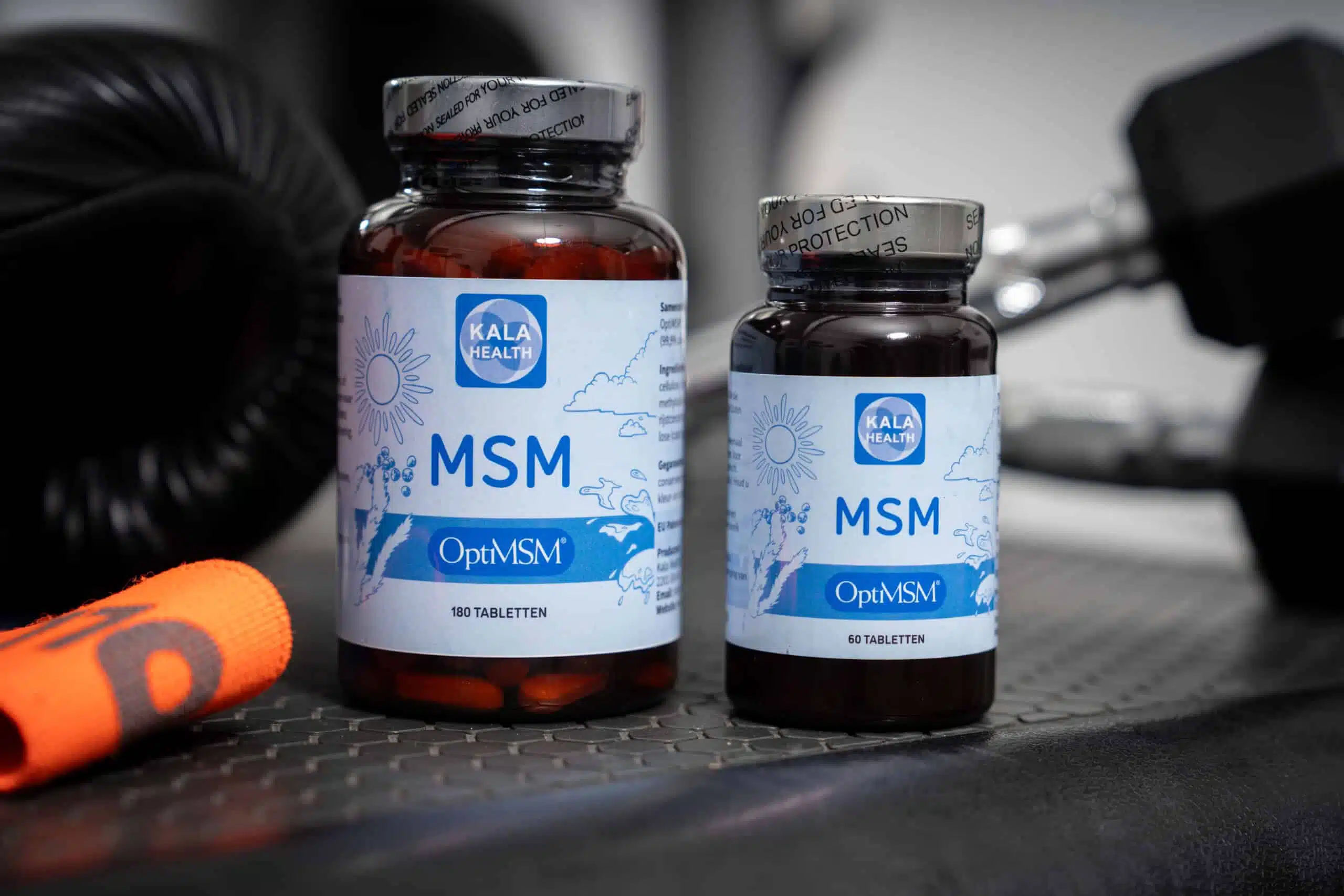







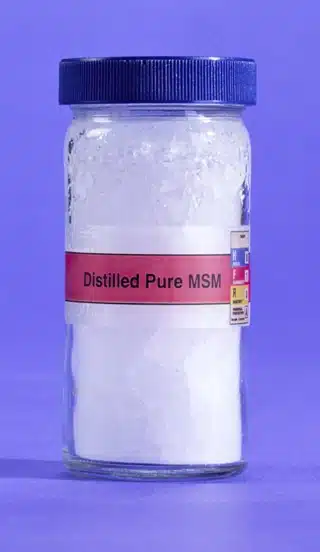


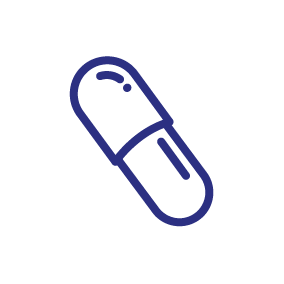 60 or 180 capsules
60 or 180 capsules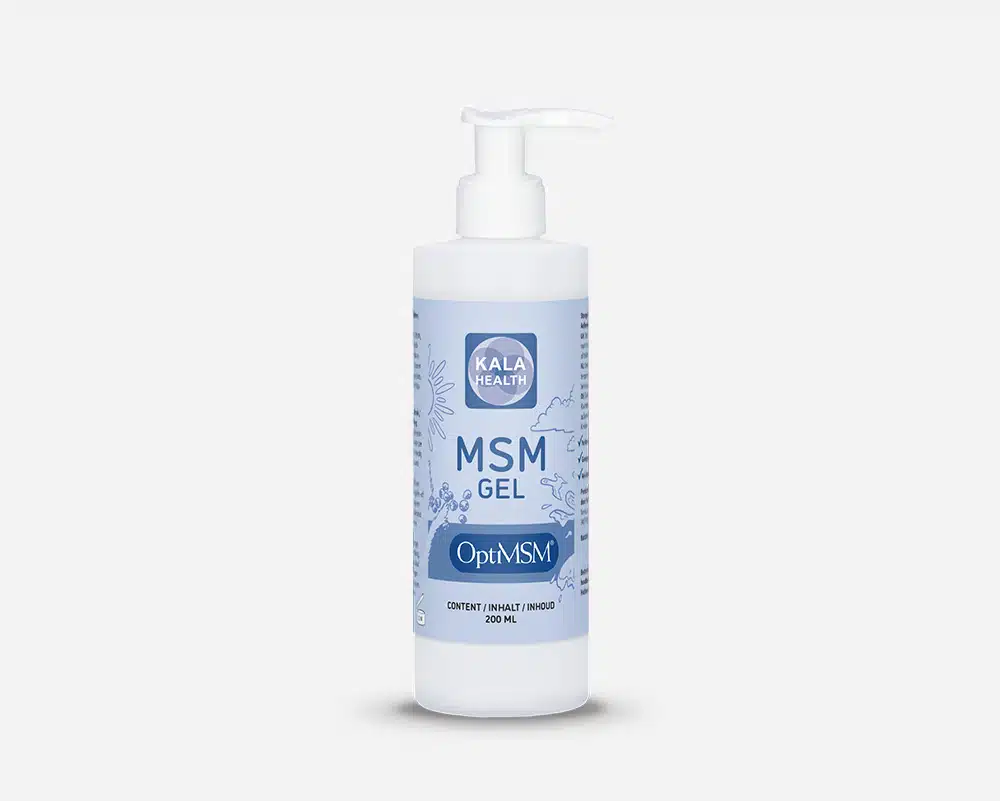
 200ml
200ml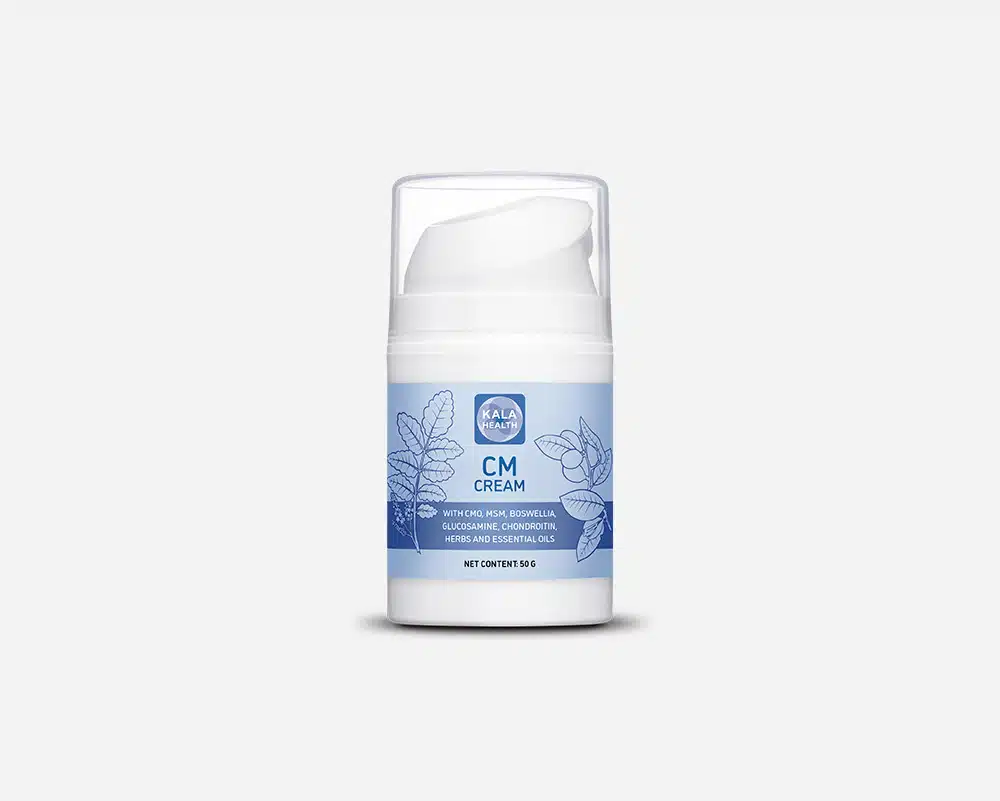
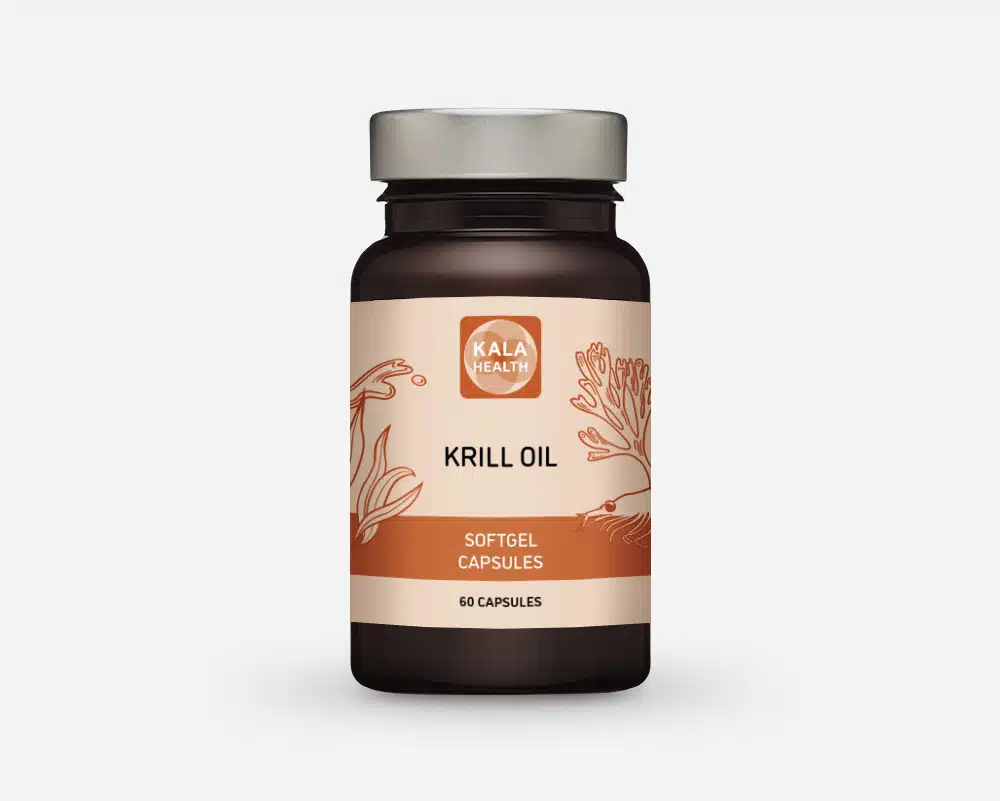
 60 or 180 Softgels
60 or 180 Softgels